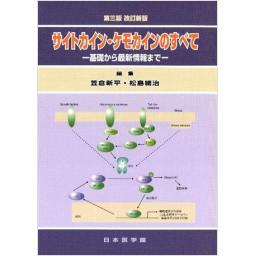3) 西本憲弘, 吉崎和幸, 嶋 良仁・他:ヒト型抗IL-6 受容体抗体を用いたミエローマ, キャッスルマン病, 慢性関節リウマチの治療. 治療学 30:66-69, 1996.
8) Waksmann BH:Lymphokine research:a historical overview. Lymphokine Reports 1:1-6, 1980.
25) Disanto Jp, Dautry-Varsat A, Ceitain S et al.:Interleukin 2 (IL-2) receptorγ-chain mutations in X-linked severe combined immunodeficiency disease result in the loss of high-affinity IL-2 receptor binding. Eur. J. Immunol. 24:475-479, 1994.
29) Leonard WJ, O'Shea JJ:Jaks and STATs:Biological implications. Annu. Rev. Immunol. 13:369-398, 1995.
36) Sakamoto H, Yasukawa H, Masuhara M et al.:A Janus kinase inhibitor, JAB, is an interferon-γ inducible gene and confers resistance to interferons. Blood 92:1668-1676, 1998.
39) Weinstock JV, Elliott D:The substance P and somatostatin interferon-γ immunoregulatory circuit. Ann. N Y Acad. Sci. 840:532-539, 1998.
44) Okamura H, Tsutsui H, Komatsu T et al.:Cloning of a new cytokine that induces IFN-γ production by T cells. Nature 378:88-91, 1995.
53) Ogasawara K, Takeda K, Hashimoto W et al.:Involvement of NK1+ T cells and their IFN-γ production in the generalyzed Schwartzman reaction. J. Immunol. 160:3522-3527, 1998.
55) Szabo SJ, Sullivan BM, Stemmann C et al.:Distinct effects of T-bet in Th1 lineage commitment and IFN-γ production in CD4 and CD8 T cells. Science 295:338-342, 2000,
59) Katamura K, Shintaku N, Yamauchi Y et al.:Prostaglandin E2 at priming of naTve CD4+Tcells inhibits acquisition of ability to produce IFN-γ and IL-12, but not IL-5 and IL-4. J. Immunol. 155:4604-4612, 1995.
71) Jiang H, Lin JJ, Su Z et al.:Subtraction hybridization identifies a novel melanoma differentiation associated gene, mda-7, modulated during human melanoma differentiation, growth and progression. Oncogenes 11:2477-2486, 1995.
